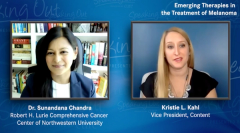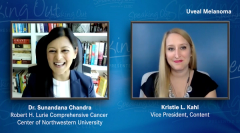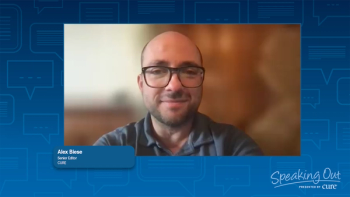
Uveal Melanoma
The basics of uveal melanoma
Kristie L. Kahl: Can you explain what uveal melanoma is and how common is this disease?
Dr. Sunandana Chandra: So uveal melanoma is a melanoma that arises in the eye. It's not spread to the eye from other organs. It involves specific structures in the eye, namely the iris, the ciliary body or the choroid. And together these encompass what we call uveal melanoma. And it is very, very rare. It approximately affects about 2,000 adults in the United States every year.
Kristie L. Kahl: What are the signs and symptoms of this type of melanoma?
Dr. Sunandana Chandra: So signs and symptoms include blurred vision, floaters, flashing lights misting of the eye, but it is important to know that sometimes it may not cause any symptoms at all, and instead is found on routine ophthalmic exams. So it's very important for us to see our optometrist or ophthalmology doctors on a routine basis.
Kristie L. Kahl: With this disease, what are the current standards of care or the main types of treatment for uveal melanoma across its different stages?
Dr. Sunandana Chandra: So in localized disease where the uveal melanoma has not spread to distant sites, the mainstays of therapy are usually radiation and surgery. In metastatic disease, meaning that uveal melanoma has spread to other organs in the body, clinical trials should be considered whenever possible, and immunotherapy may also be used for metastatic or stage 4 uveal melanoma.
Kristie L. Kahl: Speaking of clinical trials, what are some new treatments that are being evaluated, likethe IMCgp100 trial?
Dr. Sunandana Chandra: In uveal melanoma, immunotherapy is being studied in the preventative setting, as is targeted therapies such as these class of drugs called tyrosine kinase inhibitors. And in the metastatic uveal melanoma setting, we are evaluating clinical trials for these patients. In the metastatic setting, there was a recent phase 3 clinical trial known as the IMCgp100-202 trial in which patients were randomized to a new drug called tebentafusp compared to their doctor's choice of either chemotherapy or immunotherapy. And the trial showed a survival benefit for patients who received tebentafusp, which is extremely exciting and very promising for this rare subtype of melanoma.
Kristie L. Kahl: What do patients have to look forward to?
Dr. Sunandana Chandra: You know, melanoma is being understood more and more, I think, compared to about a decade ago. The armamentarium of therapy options we have now has been greater than ever before. And I think it's only going to increase, which requires a lot of multidisciplinary care, meaning between the medical oncologists, the surgical oncologist, the dermatologist, the radiation oncologist, not to mention our radiology colleagues and our pathology colleagues. And together, I think we have made some great strides and understanding melanoma, understanding why some melanomas don't respond to some therapies. And I think there's a lot of promise on the horizon looking at these newer therapies in novel combinations. So I do think that the next few years will show a lot of promise in the way we treat our melanoma patients.







